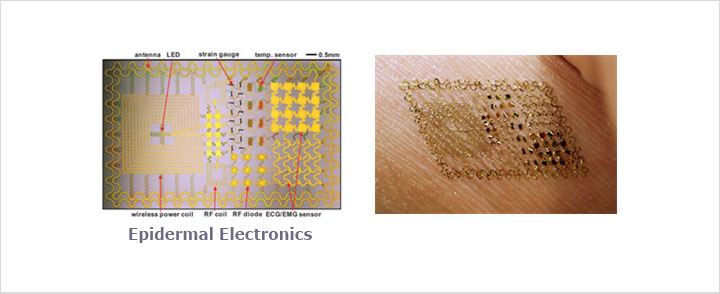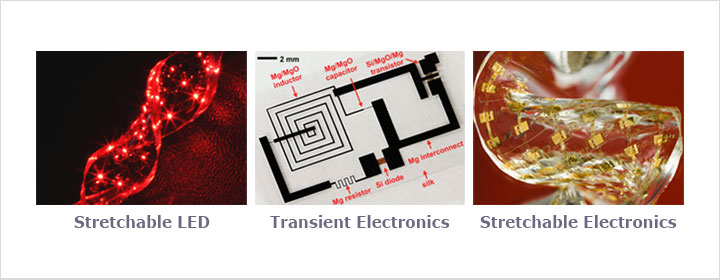mainmenu
Research
Prof.Daehyeong Kim
Synthesis and application of nanocrystals
High Performance Bio-integrated Devices for Clinical Applications
Our research aims to develop technologies for high performance flexible and stretchable electronic devices using high quality single crystal inorganic materials that enable a new generation of implantable biomedical systems with novel capabilities and increased performance. Implantable systems for brain-machine interfaces and clinical cardiology represent two examples where the devices that we have achieved offer vast improvement in measurement resolution, recording speeds, sensitivity and signal quality, compared to existing technologies.
The capabilities, in fact, approach those of devices based on conventional, wafer-based technologies but without the associated constraints for use on in-vitro, planar tissue slices or in destructive modes that involve penetrating pins into target tissues. Our technologies provide soft, conformable devices that can establish intimate contacts to curvilinear surfaces of brain and heart, without any damage or alteration in the tissue, with important, clinically relevant modes of use. The key idea behind these high performance flexible and stretchable electronic systems is the use of conventional high quality inorganic materials in structured nanomembranes designed to reduce bending-induced strains by several orders of magnitude.
Direct transfer printing of these structures provides an effective assembly and integration strategy; neutral mechanical plane designs with mechanically optimized noncoplanar serpentine layouts, and elastomeric substrates, yield the desired stretchable/flexible forms needed for conformal integration on soft, three dimensional tissues. In the area of clinical device research, we have collaborated closely with practicing cardiologists to demonstrate our devices for recording cardiac electrophysiology, in-vivo, using a swine model with high spatial and temporal resolution. Constant current source and multiplexing circuits using silicon transistors were built on flexible plastic substrates for high resolution in-situ electrocardiography mapping array.
We also applied stretchable electronics technology to create advanced, multifunctional balloon catheters that incorporate simultaneous electrical, pressure, temperature and blood flow sensors. The catheters also included the capability to electrically pace and ablate the heart tissues and LEDs to trigger future light-modulated drugs. These advanced diagnostic and therapeutic tools improve current surgical capabilities for treating arrhythmias and other cardiac diseases, due to their minimally invasive modes, and rapid capabilities for obtaining high resolution potential maps of large area cardiac surfaces and other physiological information simultaneously without manual repositioning of electrodes.
High resolution and real time interface with the brain will enable advanced micro-seizure detection and epilepsy prediction that current clinical technology cannot provide as well as high-performance brain computer interface technology for neuro-prosthetic systems. In the area of clinical medicine, the technology that we have developed is already being used for research in feline animal models of epilepsy to understand the brain network activity that initiates, sustains and terminates seizures. Improved conformal contacts between electrodes and brain tissues enable high quality electrocorticography recording.
These achievements were published in high impact journals and honored through several awards. In the future, we plan to continue to collaborate with both clinicians and biomedical device companies to help patients and advance basic research though commercializing these technologies.




